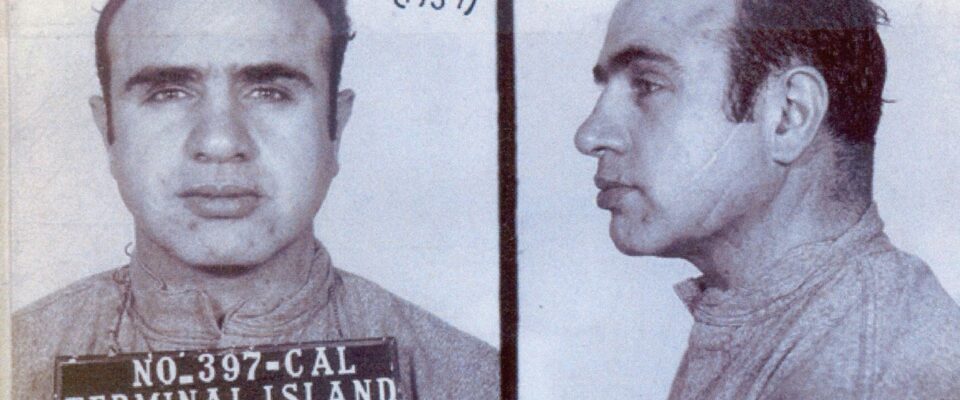Early Life
Al Capone, also known as “Scarface”, has become a symbol of the 1920s. He was an active participant in Chicago’s mob scene as he ran speakeasies during Prohibition and committed tax fraud. Before gaining notoriety in Chicago, Capone lived in Brooklyn, New York. He was born there on January 17, 1899. His parents were Gabriele, a barber, and Teresa, a seamstress. They immigrated to the United States from the Naples area in Italy. In total the couple had eight children, some were born in Italy but others, like Al, were born in the United States. Two of Al’s brothers, Raffaele James and Salvatore followed him into the crime business. Ralph managed bottling companies, which earned him the nickname “Bottles.” He worked with Al until his arrest for tax evasion in 1932. Salvatore worked with Al until he died on April 1, 1924. Al’s other brother, James Vincenzo, did not join crime business. He took the opposite path becoming a prohibition agent in Nebraska. He changed his name to Richard Hart severing all connections to his criminal family.
While growing up in Brooklyn, Al Capone did exactly what one would expect a future mobster to do. When he was fourteen years old he hit his teacher in the face, for unknown reasons. This earned him expulsion from school. Following his expulsion Capone worked odd jobs at a candy store and then a bowling alley. Through working he gained business skills that he carried into his criminal career. While he often got involved in trouble, it was not all he did. Al Capone played semi-professional baseball with his brother Ralph from 1916-1918. At some point during this time, Al met Johnny Torrio of the James Street Gang. It was after this friendship formed that Al Capone’s career as a criminal began.
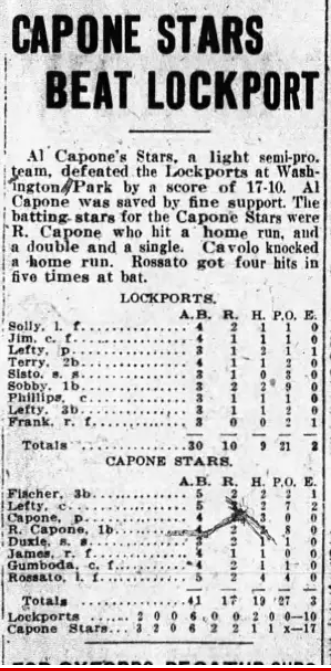
“Al Capone Played Semi-pro Baseball in Brooklyn before Turning to Crime.” New York Post. New York Post, May 17, 2020. https://nypost.com/2020/05/17/al-capone-played-semi-pro-baseball-before-turning-to-crime/.
Mae Capone
Al Capone’s wife, Mae, was a stabilizing force in his life. Mae was born Mary Josephine Coughlin on April 11, 1897. Her parents were Irish Immigrants and she was from Brooklyn, NY as well. It’s unknown when Al and Mae met, but they got married in 1918. At the time of their marriage Al was under the age of 21, so his parents needed to sign their consent. Al and Mae’s only son, Albert Francis “Sonny” Capone, was born three weeks before their wedding.
Throughout their marriage, Mae was loyal to Al in all the ways a wife could be. She would often defend him from the press. Multitudes of accounts claimed the couple’s marriage a happy one. This is hard to believe as Al cheated on his wife frequently. Early in his criminal career he contracted syphilis, which he then passed on to Mae. This diagnosis possibly contributed to the miscarriages and stillbirths Mae suffered. At one point Mae became so fed up with Al’s infidelity that she had her hair done in the same style as his current mistress. She did this to embarrass him publicly, as he enjoyed picking out the hairdos of his lovers. This moment was one of the only times Mae appeared in the press, as she kept her life private.
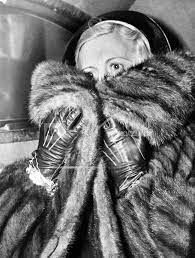
“Mae Capone 1936.” AP. Accessed April 29, 2023. https://newsroom.ap.org/editorial-photos-videos/detail?itemid=4b44fc07ae0440f7a16d96c1f316c503&mediatype=photo.
Criminal Career
After he met Johnny Torrio Al jumped between small New York gangs. These were the “Junior Forty Thieves,” the “Bowery Boys,” and the “Brooklyn Rippers.” In time Al joined the “Five Points Gang”. The “Five Points Gang” was a larger, powerful gang that operated in lower Manhattan. The gang operated clubs before Prohibition laws passed into law. One night Al mocked a sex worker at one of these clubs. The sex worker’s brother repaid Al with a laceration across the left side of his face that left a scar. The aforementioned wound became the origin for his nickname, “Scarface.”
Torrio left New York for new opportunity in Chicago. After establishing the “Chicago Outfit” also known as the “South Side Gang” in Chicago he invited Al to join him there in 1919. Al Capone started his Chicago criminal career as a bouncer at a brothel. Prohibition laws passed in 1920 eliminated the Chicago gang’s main sources of income. The gang earned back the lost income, and gained some, through breaking those laws. They operated underground breweries and distilleries. The had the contraband alcohol smuggled throughout the country. Torrio was the boss of the Chicago gang until he suffered a grievous wound in 1925. Torrio promoted Al Capone to act as boss in his stead. This promotion placed twenty-six year old Capone at the head of all business ventures. He implemented violent tactics to improve revenue. These measures were not new to gang operations, but Al implemented them as the new standard. Over time Capone became vulnerable to arrest due to his new role and the actions he took in it. In 1927 he bought a home in Miami, this home served as a safe compound out of Chicago PD jurisdiction. After Capone purchased the home he would retreat there with his family or friends. Oftentimes he escaped there when he was in need of an alibi. In one instance Capone retreated to his Miami safe haven to void him as a suspect in the St. Valentine Day murders . Capone could not have commited the crime with his own hands; albeit the Chicago press and police department speculated that he called for the murders.
“Hell, it’s a business… All I do is supply a public demand. I do it in the best and least harmful way I can. I can’t change the conditions. I just meet them without backing up.”
Gomes, Mario. “The Real Al Capone Quotes.” The Real Al Capone quotes. Accessed April 29, 2023. https://www.myalcaponemuseum.com/id211.htm.
Trial and Arrest
Capone retreated to Miami for the first three months of 1929. In March a subpoena demanded he appear before a federal court in Chicago. Capone wished to avoid Chicago. He requested Dr. Kenneth Phillips submit an affidavit to Chicago’s courts. Dr. Phillips testified to the courts that Al was bedridden as a result of pneumonia. The affidavit disclosed that travel while Capone recovered could deteriorate his health further. The Chicago courts postponed Al Capone’s appearance to March 20, 1929. The FBI was reluctant to believe there was any truth to the sworn affidavit. They had already been compiling a file on Capone, due to his criminal activity in Chicago. So, they looked into the veracity of Dr. Phillip’s affidavit. Their suspicions proved valid. The FBI discovered Al went to the horse races and on vacation during the time he was on bed rest.
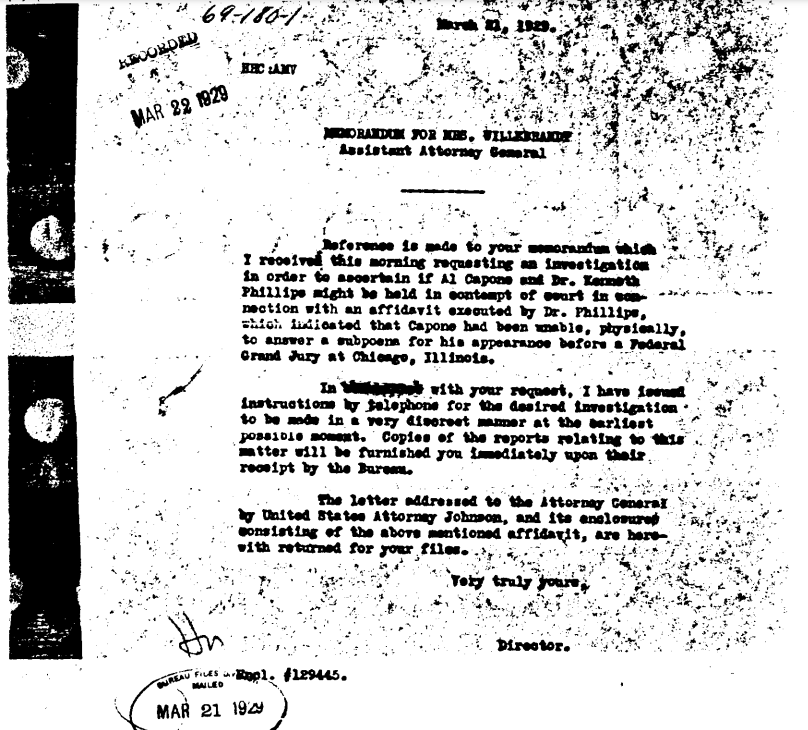
National Archives. Accessed April 29, 2023. https://webharvest.gov/peth04/20041018050243/http://foia.fbi.gov/capone/capone7a.pdf
Capone was present for court on March 20th and proceedings lasted until the 27th. On the last day of the proceedings the court charged Al with contempt of court and arrested him. A $5,000 bond for his release. This was only the beginning of Capone’s serious legal troubles though. Police arrested him and his bodyguard the following May in Philadelphia, PA . The pair were in possession of deadly weapons. Philadelphia courts sentenced Capone to one year in prison. In March 1930 the prison liberated Capone two months early for good behavior. In February 1931 Chicago courts charged Capone with contempt of court. They sentenced Capone to six months in Cook County jail. For one reason or another did not serve the sentence immediately.
Post his February conviction, Al Capone was finally tried for tax evasion in October 1931. He entered a plea deal for a lighter sentence at the start of trial. Capone ended up forgoing the deal because the judge was under no obligation to uphold it. In the end, Chicago courts sentenced him to eleven years in prison in October 1931. The six months he owed for his earlier charge of contempt in court joined the eleven year sentence. Furthermore the courts required Capone pay a $50,000 fine, $7.692 in court costs, and $215,000 that he owed in back taxes.
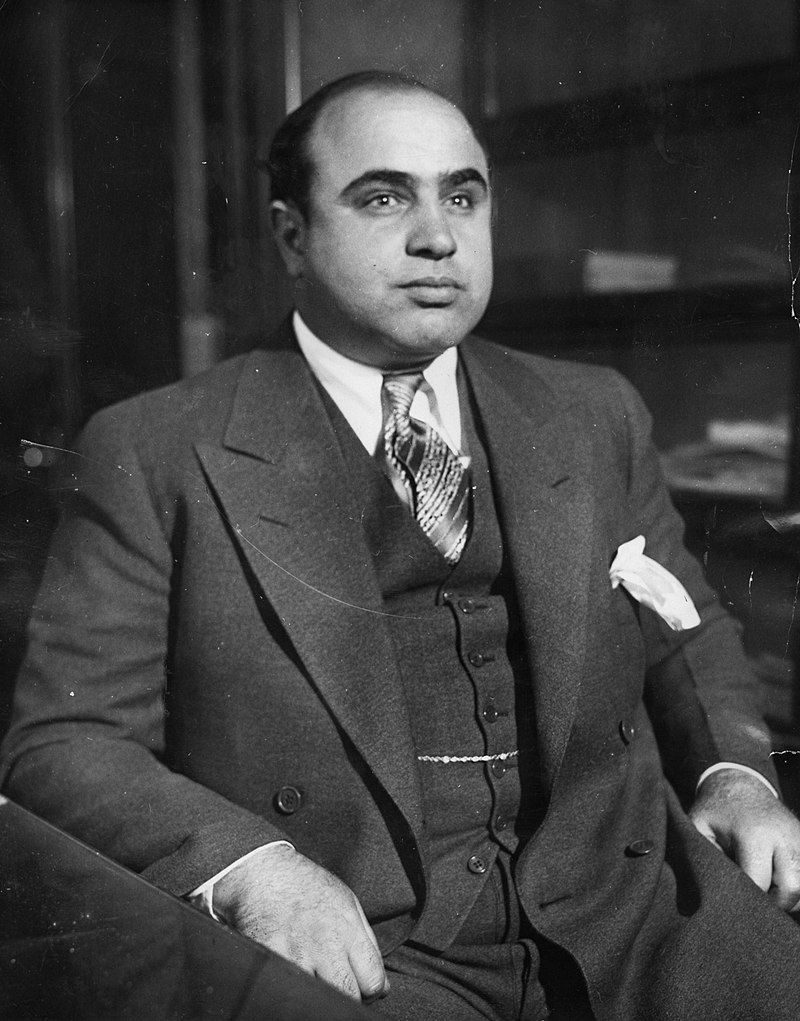
Photo from Chicago Detective Bureau, Public Domain, found on Wikipedia
Release from Prison and Death
Al Capone served seven years, six months and fifteen days in prison. Alcatraz prison released him on November 16, 1939 after paying all fines and back taxes. Capone spent his time after release in a Baltimore hospital for brain treatment. His health was declining due to his syphilis infection. Upon his release from the hospital, Mae took him to the Miami home he often escaped to. Al Capone never returned to Chicago. Mae cared for him there until he died in 1947 at 48 years old. She sold their Miami home soon after his passing, but remained in Florida until her death in 1986 at 89 years old.
Later Media Portrayal
Al Capone rose to celebrity status during his life despite his criminal career. He earned this societal status by dressing to the nines, and flaunting his accumulated wealth at any opportunity. A pinstripe suit remains the unofficial uniform of a 1920s gangster. The luxury the public perceived he lived in led to others glamourising life in his shoes. Some had no desire to live their lives that way, but found themselves awestruck in fear of him. The point is that no matter what people thought of Capone, the public thought of him.
In 1930, the novel Scarface by Armitage Trail released to the public. Trail drew inspiration from the real life Scarface, Al Capone. It followed a young “hoodlum” named Tony Guarino. Guarino got himself into so much trouble his boss ordered him to stay away from Chicago. As a result he volunteered his service in WWI. It was during his time serving in the war he received a wound to his face that was so bad his family didn’t recognize him. He was also pronounced dead due to a clerical mistake. He changed his name and became the boss of his own gang. In 1932 a movie adaptation of this novel released in theatres. The original “Scarface”, Al Capone, faced trial after trial during these releases. The criminal lifestyle had become a source for public entertainment. This was the beginning of the long history of Mafia media portrayal.
A few decades later in 1983, the Scarface film was redone, and it was a box office hit. Al Pacino starred as Scarface which launched at the height of a mafia movie renaissance. During the 1970s, mafia movies dominated popular culture. The first two Godfather films released in 1972 and 1974. These movies were not specifically based on Al Capone. Italian immigration and the activity of the mafia that developed in the United States during the early nineteenth century inspired the plot of the Godfather films. The remake of Scarface followed these films. Al Pacino starred in Godfather I before Scarface and he became the poster child for mafia media portrayal. The two characters Pacino played provided the public with insight into the different types of men that existed within the glamorized mafia world. Mafia movies also launched Robert De Niro’s career with Godfather II. In the 1990s Goodfellas directed by Martin Scorsese became another mafia classic. This all culminated with the launch of on HBO. All of this popular media would not be possible without the original Scarface, Al Capone, and the social status he rose to despite being a violent criminal. He was an iconic, mysterious figure during his time in the 1920s. The intrigue he commanded then has resulted in a whole entertainment genre that will continue to be enjoyed.
Bibliography
“Al (Alphone) Capone FBI Reels.” Federal Bureau of Investigation – Freedom of Information Privacy Act. Accessed April 30, 2023. https://webharvest.gov/peth04/20041015012040/http:/foia.fbi.gov/index.html.
“Al Capone.” FBI. FBI, May 18, 2016. https://www.fbi.gov/history/famous-cases/al-capone.
Balsamini, Dean. “Al Capone Played Semi-pro Baseball in Brooklyn before Turning to Crime.” New York Post. New York Post, May 17, 2020. https://nypost.com/2020/05/17/al-capone-played-semi-pro-baseball-before-turning-to-crime/.
Bowman, Lisa Marie. “Novel Review: Scarface by Armitage Trail.” Through the Shattered Lens, August 15, 2022. https://unobtainium13.com/2022/01/18/novel-review-scarface-by-armitage-trail/.
Denninger, Lindsay. “Why Mae Capone Is Still Such a Mystery.” Whatever Happened To Mae Capone After Al’s Death? Accessed April 30, 2023. https://www.refinery29.com/en-us/2020/05/9774160/what-happened-to-mae-capone-al-wife.
“James Street Gang.” Infamous New York. Accessed April 30, 2023. https://infamousnewyork.com/tag/james-street-gang/.
Kobler, John. Capone: The Life and World of Al Capone. Capo, 1992.
“Mae Capone 1936.” AP. Accessed April 29, 2023. https://newsroom.ap.org/editorial-photos-videos/detail?itemid=4b44fc07ae0440f7a16d96c1f316c503&mediatype=photo.
“My Al Capone Museum.” My al capone museum. Accessed April 30, 2023. https://www.myalcaponemuseum.com/id117.htm.
National Archives. Accessed April 29, 2023. https://www.webharvest.gov/.

Michelle Steidle is a History Major at Ramapo College, graduating with the Class of 2023. She enjoys historical research, long walks on the beach, and a good joke.

